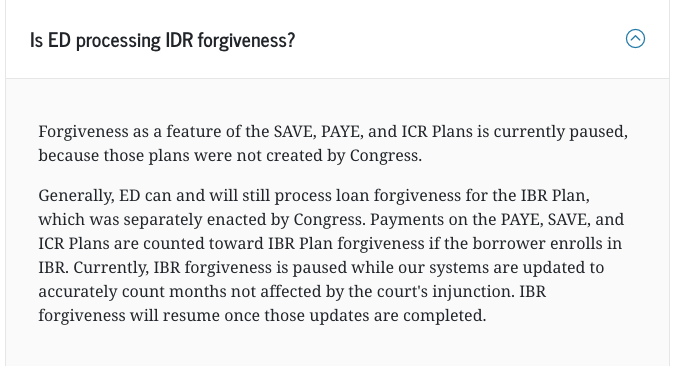Key Points
- The Department of Education has resumed Income-Based Repayment (IBR) loan forgiveness, sending out approval emails to eligible borrowers after a nearly year-long suspension.
- Forgiveness applies only to IBR borrowers, leaving those in other income-driven plans (PAYE, ICR, SAVE) still waiting amid ongoing litigation.
- Discharges are not immediate – borrowers face an opt-out window and processing delays that could stretch for weeks or months.
For the first time in nearly a year, federal student loan borrowers are seeing their balances forgiven under the Income-Based Repayment plan. On Tuesday September 30, 2025, the Department of Education sent out a wave of approval notices to borrowers who had crossed the 20- or 25-year repayment threshold under IBR.
The emails, which many borrowers referred to as “golden letters,” confirmed that the borrowers had met the timeline required for loan forgiveness, and that the Department of Education would begin the process of loan forgiveness.
The notices are significant: since 2024, the department had paused IBR forgiveness while it conducted “system updates,” leaving thousands of borrowers in limbo even after they had completed the required 240 or 300 payments. It still has this message posted on StudentAid.gov:

Would you like to save this?
IBR Forgiveness Moves Forward, Other Plans Still Stalled
The IBR plan (which was created by Congress in 2007) remains the only income-driven repayment (IDR) program with active loan forgiveness. Under IBR, borrowers who make 20 or 25 years of qualifying payments can have their remaining balance erased.
Note: Public Service Loan Forgiveness (PSLF) is still processing loan forgiveness, but it’s not directly tied to an income-driven repayment plan.
By contrast, forgiveness under other IDR plans such as Pay As You Earn (PAYE) and Income-Contingent Repayment (ICR) remains in limbo, while the Saving on a Valuable Education (SAVE) plan was completely blocked by the court.
The Department of Education has argued that ongoing lawsuits against SAVE, filed by several states, have prevented loan forgiveness across multiple IDR programs that rely on similar legal authorities.
The American Federation of Teachers (AFT), a national union, disputes that position. In September, it expanded a lawsuit against the department to include the IBR forgiveness freeze, arguing that the government has wrongly withheld relief for borrowers in PAYE and ICR. Tuesday’s wave of IBR approvals may ease some pressure, but it is unlikely to resolve the broader legal battle.
Regardless, it was a welcome message ahead of the government shutdown.
Borrower Impact
For many borrowers, the sudden arrival of forgiveness notices is life-changing. Some report balances exceeding $150,000 or $200,000 being wiped away after decades of repayment.
Others describe finally reaching discharge after years of uncertainty, particularly during the department’s months-long freeze.
The relief, however, is not evenly distributed. Borrowers in ICR, who may have reached their own eligibility thresholds, remain excluded from forgiveness.
Borrowers in PAYE will never receive loan forgiveness under PAYE, since the 20 year plan exceeds the sunset date of June 30, 2028. Those in PAYE will have to make a decision to either move to IBR, or wait for the upcoming Repayment Assistance Plan (RAP) to start in 2026.
What Borrowers Can Expect Next
While the approval emails mark a breakthrough, actual debt cancellation is not immediate. Borrowers are given an opt-out period to decline forgiveness if they wish, often due to potential state tax liabilities. If they do not opt out, the Department of Education will instruct their loan servicer to process the discharge.
That process can take time. The department says it will take up to “several months” to process. Servicers, already under strain from staffing shortages, may face delays in processing.
It’s important to note that with the return of the student loan tax bomb in 2026, this is welcome timing. From a tax perspective, the date the debt is cancelled is what is considered for taxes – which would be the date borrowers received their golden email.
Takeaways for Borrowers
- Check for emails: Eligible IBR borrowers should look for official forgiveness notices from the Department of Education or their servicer.
- Understand the opt-out: Borrowers who want to avoid possible state tax bills can decline forgiveness, though they would then remain responsible for repayment. This is not recommended.
- Prepare for timing delays: Discharges may not appear immediately in loan accounts and could take several months to finalize.
- Stay alert for legal updates: Borrowers in SAVE, PAYE, or ICR should ensure their information is updated and stay alert for potential updates from the Department of Education.
For now, the restart of IBR student loan forgiveness represents the first tangible progress in months for long-term borrowers and a sign that at least one pathway to relief is moving forward again.
Don’t Miss These Other Stories:
Editor: Colin Graves
The post IBR Student Loan Forgiveness Resumes After Pause appeared first on The College Investor.

